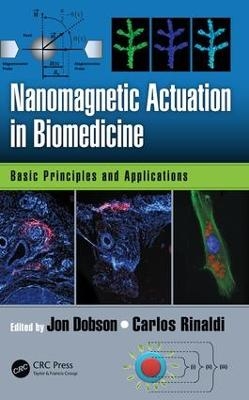
Nanomagnetic Actuation in Biomedicine
Crc Press Inc (Verlag)
978-1-4665-9121-9 (ISBN)
Key Features
Focuses on the fundamentals and applications of magnetic actuation
Includes contributions by world-class researchers from several countries and is edited by a well-known researcher in this field
Offers multidisciplinary coverage and applications
Supplies extensive references at the end of each chapter
Jon Dobson graduated with a B.Sc. and M.Sc. in Geology and Geophysics from the University of Florida. He obtained his PhD in Natural Sciences in 1991 from the Swiss Federal Institute of Technology, ETH-Zurich. He did his postdoctoral training in geophysics and biophysics at both the ETH-Zurich and The University of Western Australia, before taking a faculty position at Keele University in the United Kingdom. In 2011, he returned to the University of Florida as Professor of Biomaterials and Biomedical Engineering, and founding director of the Institute for Cell and Tissue Science and Engineering (ICTSE) at UF. Dr. Dobson’s research focuses on biomedical applications of magnetic micro- and nanoparticles, the role of brain iron in neurodegenerative diseases, and biomedical device design. He is a Fellow of the American Association for the Advancement of Science (AAAS), the American Institute for Medical and Biological Engineering (AIMBE), The Royal Society of Biology, The Royal Society of Medicine, and a past Royal Society of London Wolfson Research Merit Fellow. In 2002, he was selected for the Wellcome Trust’s Sir Henry Wellcome Showcase Award, and in 2008 the UK Medical Research Council’s César Milstein Award. He has authored or co-authored more than 190 peer-reviewed publications, including the 2nd most highly cited paper in the field, has 20 patents awarded or pending, and is co-founder of three spin-off companies. Carlos Rinaldi received his B.S. degree in Chemical Engineering from the University of Puerto Rico, Mayagüez (1998), and completed degrees in Master of Science in Chemical Engineering (2001), Master of Science in Chemical Engineering Practice (2001), and Doctor of Philosophy (2002) in Chemical Engineering at the Massachusetts Institute of Technology (MIT). During the summer of 2002 he served as Assistant Station Director for the David H. Koch School of Chemical Engineering Practice at MIT. From 2002 to 2012 he was a professor in the Department of Chemical Engineering at the University of Puerto Rico, Mayagüez. In 2012 he joined the University of Florida, with joint appointments in the J. Crayton Pruitt Family Department of Biomedical Engineering and the Department of Chemical Engineering. Carlos Rinaldi has authored and co-authored more than 120 publications in the fields of magnetic nanomaterials, fluid mechanics of magnetic nanoparticle suspensions, and nanotechnology. His research interests are in biomedical applications of magnetic nanoparticles and the fluid physics of magnetic nanoparticle suspensions. He received the Presidential Early Career Award for Scientists and Engineers (PECASE) in 2005, in recognition of his contributions to magnetic nanoparticle research and to broadening participation of under-represented groups in engineering.
Basic Principles of Nanomagnetic Actuation. Nanomagnetic Actuation for Cell and Tissue Engineering. Formation of Tissue Constructs Using Magnetic Nanoparticles. Activation of Mechanosensitive Ion Channels Using Magnetic Nanoparticles. Magnetic Twisting Cytometry. Development of Magnetic Needle Actuation Systems. The Magnetic Force Bioreactor. Nanomagnetic Activation of Cell Signaling Pathways via Receptor Clustering. Cellular Apoptosis Induced by Coupling of Radiofrequency Magnetic Fields to Receptor-Bound Magnetic Nanoparticles.
| Erscheint lt. Verlag | 24.1.2018 |
|---|---|
| Zusatzinfo | 5 Tables, black and white; 71 Illustrations, color; 26 Illustrations, black and white |
| Verlagsort | Bosa Roca |
| Sprache | englisch |
| Maße | 156 x 234 mm |
| Gewicht | 566 g |
| Themenwelt | Medizin / Pharmazie ► Physiotherapie / Ergotherapie ► Orthopädie |
| Studium ► 1. Studienabschnitt (Vorklinik) ► Physiologie | |
| Naturwissenschaften ► Biologie | |
| Technik ► Maschinenbau | |
| Technik ► Medizintechnik | |
| Technik ► Umwelttechnik / Biotechnologie | |
| ISBN-10 | 1-4665-9121-8 / 1466591218 |
| ISBN-13 | 978-1-4665-9121-9 / 9781466591219 |
| Zustand | Neuware |
| Haben Sie eine Frage zum Produkt? |
aus dem Bereich


